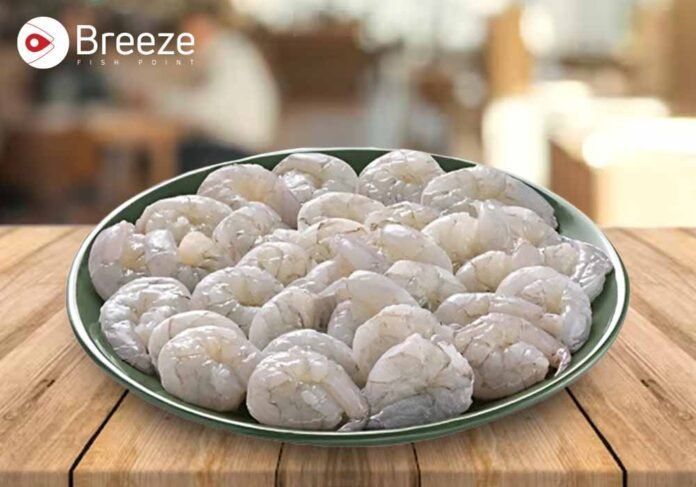Table of Contents
JHINGA FISH: WHAT IS IT?
VARIETIES OF JHINGA FISH
There are several species and varieties of jheenga fish, and each has distinct flavour, texture, and size traits. Here are some well-liked types:
- Tiger Prawns: Large, meaty, and flavorful, ideal for grilling and frying.
- King Prawns: Larger than standard prawns, have a slightly sweeter taste and firm texture, ideal for robust dishes.
- Whiteleg Shrimp: Tender texture and mild flavor, used in soups and stir-fried dishes.
- Rock Shrimp: Harder shell, rich, lobster-like taste, ideal for different flavor profiles.
- Red Shrimp: Sweet, delicate texture, commonly used in premium seafood dishes.
NUTRITIONAL VALUE OF JHINGA
Jhinga is nutrient-dense in addition to being delicious. Lean protein, good fats, and vital vitamins and minerals that promote general health are all abundant in it. Let’s examine the nutritional value of jheenga fish in more detail.
High protein content:
- Jhinga is a popular choice for health-conscious diets due to its high protein content. It provides approximately 20 grams of protein per 100 grams, supporting muscle repair, growth, and overall bodily functions.
Low in calories and fat:
- Despite being nutrient-rich, jhinga is low in calories and fat, making it ideal for weight management. A 100-gram serving contains around 100 calories and less than 1 gram of fat.
- Fat in jhinga is primarily composed of healthy omega-3 fatty acids, beneficial for heart health and reducing inflammation.
Jhinga: A Rich Source of Essential Vitamins and Minerals
Jhinga is a rich source of essential minerals and vitamins, such as:
- Vitamin B12: Essential for nerve function, brain health, and red blood cell formation.
- Selenium: Powerful antioxidant, protecting cells from oxidative stress and supporting immune function.
- Phosphorus: Vital for strong bones and teeth, plays in energy production and storage.
- Zinc: Supports immune health, wound healing, and cell production.
Jhinga: Safer Choice for Mercury Consumption
- Lower mercury levels compared to other seafood.
- Pregnant women and young children can benefit from nutrient-dense meal.
HEALTH BENEFITS OF JHINGA
Jhinga has a balanced nutritional composition and provides a number of health advantages that can improve general wellbeing. The following are the main advantages of eating jhinga:
- Supports Heart Health: Omega-3 fatty acids in jhinga reduce cholesterol, lower blood pressure, and decrease inflammation, reducing the risk of heart disease.
- Promotes Weight Management: Jhinga’s low calorie and high protein content aids in weight management by providing satiety without adding excess calories.
- Enhances Brain Health: DHA, an omega-3 fatty acid, supports brain function and mental clarity, improving cognitive function and mood.
- Boosts Immunity: High levels of selenium and zinc in jhinga support immune health, acting as antioxidants and immune cell producers.
- Strengthens Bones and Joints: Phosphorus and calcium in jhinga contribute to bone health and prevention of bone-related disorders.
CULINARY USES OF JHINGA
When used in the kitchen, jhinga lends itself to a wide range of flavours and cooking methods. The following are some common ways to eat jhinga:
Grilled Jhinga:
- Enhances natural sweetness and smoky flavor.
- Marinated with herbs, lemon juice, and garlic.
Fried Prawns:
- Serves as a crunchy treat with a tangy dipping sauce.
Jhinga Curry:
- A popular South Asian dish simmering prawns in a flavorful sauce.
- Pairs well with rice or flatbread.
Prawn Salad:
- Light and refreshing salad with fresh greens, avocado, and citrus dressing.
Stir-Fried Jhinga:
- Quick and satisfying meal with vegetables, ginger, and soy sauce.
Jhinga Fusion:
- Blends flavors from different cuisines.
- Used in prawn tacos, sushi rolls, and pizza.
NUTRITIONAL VALUE COMPARISON: JHINGA VS. OTHER SEAFOOD
The nutritional value of jhinga is comparable to that of other well-liked seafood choices. Here is a quick analogy:
- Salmon: Known for its high omega-3 content, salmon is perfect for people who are concerned about brain health because it has more DHA and a slightly greater fat content than jhinga.
- Tuna: Like jhinga, tuna has a high protein level, but it can also contain more mercury, thus it should only be consumed in moderation.
- Cod: Cod is a mild-tasting, lean white fish that has less fat and calories than jhinga but less omega-3.
Although every seafood kind has benefits of its own, jhinga is a balanced option that provides protein, omega-3 fatty acids, and vital vitamins and minerals without being overly high in calories or mercury.
TIPS FOR BUYING AND STORING JHINGA
Fresh or well frozen prawns are the finest option for jhinga in terms of taste and nutritional value. The following advice is provided:
- Choose fresh prawns with firm texture, mild ocean-like smell, and translucent appearance. Avoid fishy odor or slimy texture.
- Store fresh prawns in refrigerator and consume within a day or two of purchase.
- For frozen prawns, freeze until ready to use and defrost in the refrigerator or under cold running water.
- Avoid overcooking as jhinga cooks quickly, so watch cooking time carefully.




